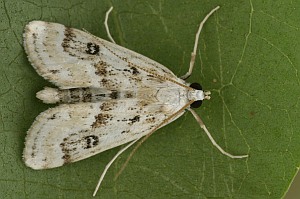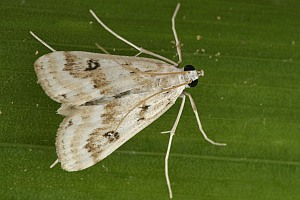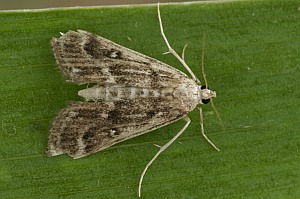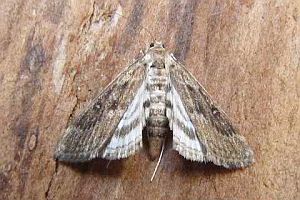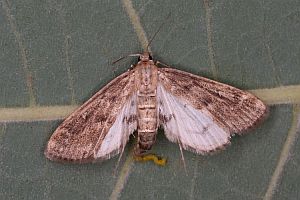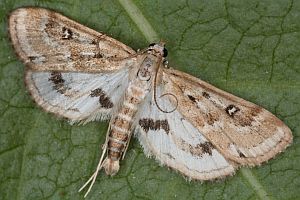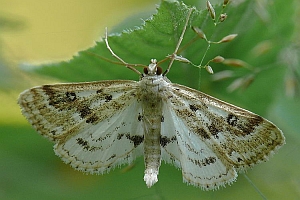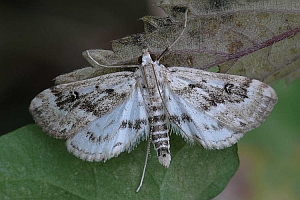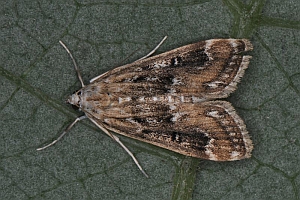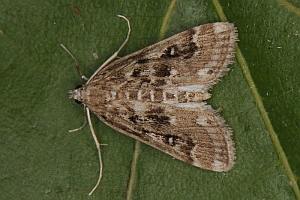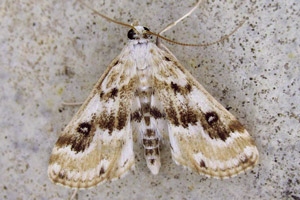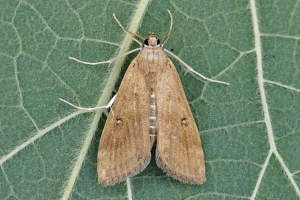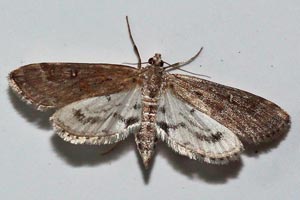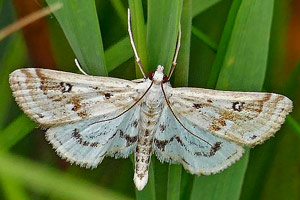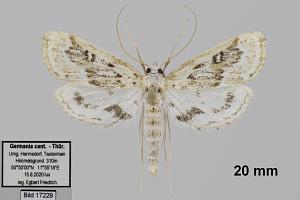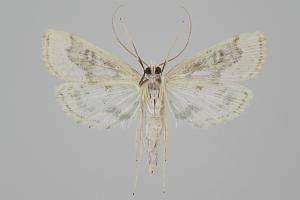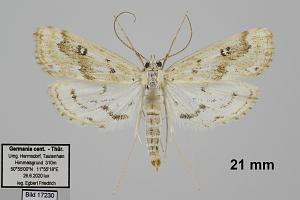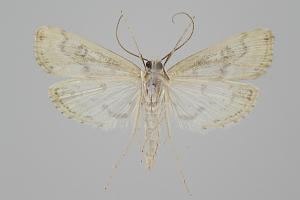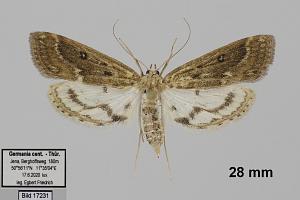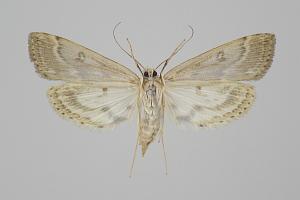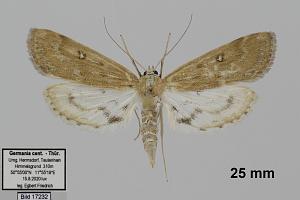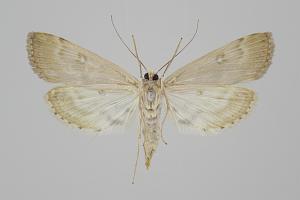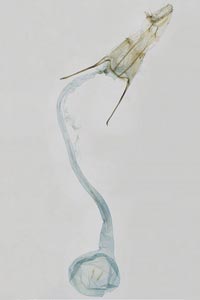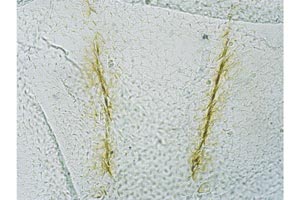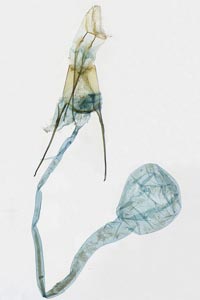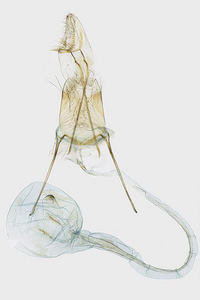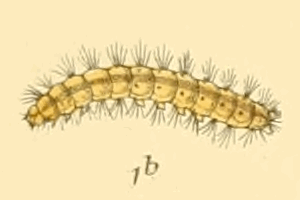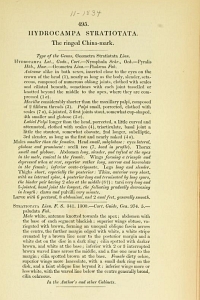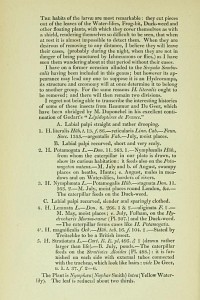

 +48Kontinente:EUASAF
+48Kontinente:EUASAF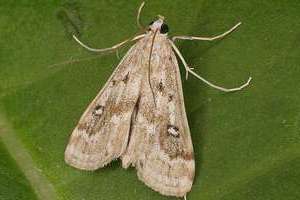
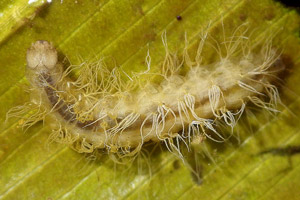
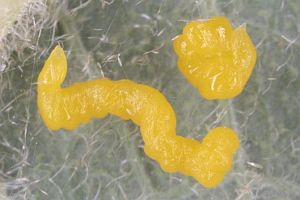
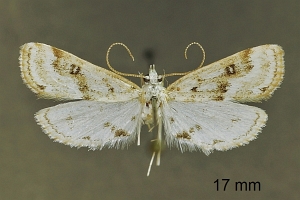
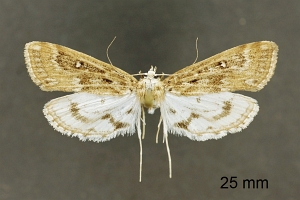
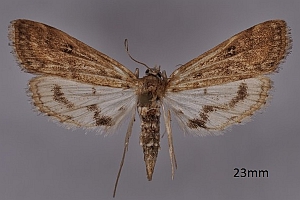
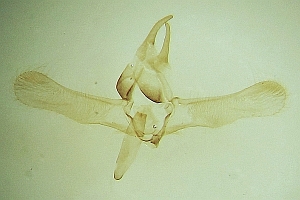
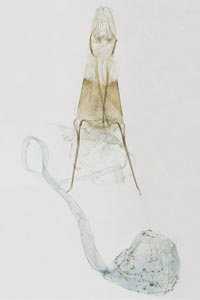


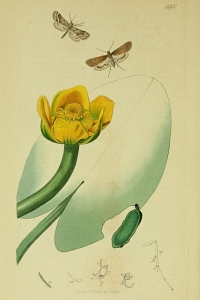
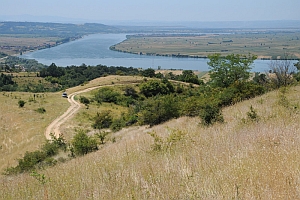
1. Lebendfotos
1.1. Falter
1.2. Raupe
1.3. Ei
2. Diagnose
2.1. Männchen
2.2. Weibchen
2.3. Geschlecht nicht bestimmt
2.4. Genitalien
2.4.1. Männchen
2.4.2. Weibchen
2.5. Raupe
2.6. Erstbeschreibung
2.7. Beschreibung von John Curtis als Hydrocampa stratiotata
3. Biologie
3.1. Habitat
3.2. Nahrung der Raupe
Nach Goater et al. (2005) lebt die Raupe vor allem am Ährigen Tausendblatt (Myriophyllum spicatum). Die namengebende Stratiotes aloides (Krebsschere, Wasseraloe) fehlt an den meisten Fundstellen des Falters, kann also allenfalls untergeordnete Bedeutung als Raupennahrung haben (weshalb der mitunter zu findende deutsche Name "Wasseraloezünsler" hier auch nicht benutzt wird). Nach Goater et al. (2005) ist aber auch diese Raupe recht polyphag; bei ihrer Auflistung ist nicht sicher, ob es sich stets um Freilandbeobachtungen handelt:
- [Haloragaceae:] Myriophyllum spicatum (Ähriges Tausendblatt, Ährenblütiges Tausendblatt)
- [Haloragaceae:] Myriophyllum verticillatum (Quirliges Tausendblatt)
- [Hydrocharitaceae:] Stratiotes aloides (Krebsschere, Wasseraloe)
- [Hydrocharitaceae:] Elodea sp. (Wasserpest)
- [Hydrocharitaceae:] Hydrocharis morsus-ranae (Europäischer Froschbiss)
- [Ceratophyllaceae:] Ceratophyllum demersum (Raues Hornblatt, Rauhes Hornblatt)
- [Plantaginaceae:] Callitriche palustris [= Callitriche verna] (Sumpf-Wasserstern, Frühlings-Wasserstern)
- [Lythraceae:] Trapa natans (Wassernuss)
- [Potamogetonaceae:] Potamogeton crispus (Krauses Laichkraut)
- [Nymphaeaceae:] Nymphaea alba (Weiße Seerose)
- [Alismataceae:] Alisma plantago-aquatica (Gewöhnlicher Froschlöffel)
(Autor: Erwin Rennwald)
4. Weitere Informationen
4.1. Etymologie (Namenserklärung)
„stratiotes Wasseraloë.“
[nach Stratiotes aloides (Krebsschere, Wasseraloe), einer (minder bedeutsamen) Raupennahrungspflanze der Art]
4.2. Andere Kombinationen
- Phalaena stratiotata Linnaeus, 1758 [Originalkombination]
4.3. Synonyme
- Parapoynx andalusicum Speidel, 1982 [K+R-Nr: 06426] [synonymisiert durch Leraut (2012: 129)]
- Parapoynx andalusica Speidel, 1982 [falsche Schreibweise in der Fauna Europaea]
- Parapoynx maroccanum Speidel, 1982 [synonymisiert durch Leraut (2012: 129)]
- Parapoynx maroccana Speidel, 1982 [falsche Schreibweise]
4.4. Unterarten
- Parapoynx stratiotata maroccanum Speidel, 1982 [Marokko, Südspanien]
4.5. Taxonomie
Was ist mit der aus Spanien beschriebenen Parapoynx andalusicum Speidel, 1982 bzw. Parapoynx andalusica Speidel, 1982 ? Die Art wurde von Speidel (1982: 15-16) anhand eines einzigen Weibchens aus El Rocio (Süd-Spanien, Andalusien, Provinz Huelva) beschrieben. Auf der Seite davor (14-15) hatte der Autor bereits Parapoynx maroccanum als weitere neue Art beschrieben - hier auf der Basis von 6 Männchen und 10 Weibchen aus Marokko. Speidel (1984: 80-81) wiederholte die Angaben zu diesen beiden neuen Arten im wesentlichen. Auch Goater et al. (2005) kannten noch kein einziges weiteres Exemplar von P. andalusicum, vermuteten aber, dass einige Meldungen zu Parapoynx stratiotata auf der Iberischen Halbinsel in Wirklichkeit zu dieser Art gehören könnten. Pérez De-Gregorio(2006: 302) akzeptierte die aus Andalusien beschriebene Art weiterhin: "Endemismo ibérico, descrito de El Rocío (Huelva) (Speidel, 1982) y que habita Andalucía y el sudoeste de Portugal (Algarve). Podemos confirmar la suposición de Speidel (1983, 2005) de que las citas andaluzas de P. stratiotata (Linnaeus, 1758) (Adra, provincia de Almería, Agenjo, 1952) corresponden a P. andalusicum, tras examinar el material citado por este autor (2 hembras capturadas en Adra, provincia de Almería, VI.1948 Agenjo leg., colección Agenjo, MNCN)."
Goater et al. (2005: 60) hatten allerdings bei P. stratiotata schon vermerkt: "P. marrocana Speidel, 1982 is confined to North Africa. This species and P. stratiotata are allopatric as far as currently known. The slight morphological differences between these two taxa may necessitate downgrading P. marrocana to a subspecies of P. stratiotata if intermediate populations (e.g. in the southern part of the Iberian Peninsula) provide evidence for interbreeding. However in south Spain only P. andalusicum is known at present. This certainly seems to be another biospecies which is not intermediate between the two taxa morphologically."
Agassiz (2012) und Leraut (2012: 129) überführten - anscheinend unabhängig voneinander - beide P. maroccanum auch formal in den Rang einer Supspecies von P. stratiotata. Leraut (2012: 129) ging dabei auch auf das spanische Taxon ein: "My examination of a large batch of specimens from Europe and North Africa showed, tha the genitalia of both sexes of these regions were in fact identical. The development of small signa on the bursa in the female, in particular, varies within particular populations and cannot be used as distinguishing characters. [...] The only character which is anywhere near constant in the populations from Morocco is the doubling of the hindwing transverse line, and this is justification for my maintaining the taxon maroccana Speidel, 1982 as a subspecies, from which the taxon andalusica Speidel, 1982 cannot in any way be distinguished.
4.6. Faunistik
Das Taxon Parapoynx andalusicum wurde anhand eines einzigen Weibchens aus El Rocio (Süd-Spanien, Andalusien, Provinz Huelva) beschrieben. Goater et al. (2005) kannten noch kein weiteres Exemplar der Art, vermuteten aber, dass einige Meldungen zu Parapoynx stratiotata auf der Iberischen Halbinsel in Wirklichkeit zu dieser Art gehören könnten. Die Fauna Europaea [Fauna Europaea, last update 29 August 2013, version 2.6.2] nennt neben Spanien jetzt auch Portugal als Teil des Verbreitungsgebietsder P. andalusica.
Vives Moreno (2014: 443) akzeptiert die Auffassung von Leraut (2012) und führt P. stratiotata stratiotata für Spanien, Portugal und die Balearen an, P. stratiotata maroccana für Spanien und Portugal.
P. stratiotata ist in Europa fast durchgehend zu finden und insgesamt von Nordwestafrika bis China verbreitet.
(Autor: Erwin Rennwald)
4.7. Typenmaterial
Parapoynx andalusicum: Speidel (1982: 15) beschrieb die Art nach einem einzigen Weibchen: „Holotypus: ♀: “Andal., Prov. Huelva, El Rocio, 15.IV. 38, W. Marten”; “GU 040 ♀ SP”; “HOLOTYPUS ♀, Parapoynx andalusicum n.sp., sel. Speidel 1981”. Naturhistorisches Museum Wien (NHMW).“
4.8. Literatur
- Agassiz, D.J.L. (2012): The Acentropinae (Lepidoptera: Pyraloidea: Crambidae) of Africa. — Zootaxa, 3494: 1–73. [erste Seiten auf mapress.com]
- Barrett, C. G. (1904): The Lepidoptera of the British Islands 9 Heterocera. Geometrina—Pyralidina: 1-454. pl. 377-424. London (Lovell Reeve and Co. Limited).
- Curtis, J. (1823-1840): British Entomology; Being Illustrations and Descriptions of the Genera of Insects Found in Great Britain and Ireland: Containing Coloured Figures from Nature of the Most Rare and Beautiful Species, and in Many Instances of the Plants upon which they are Found. Vol. VI. Lepidoptera, Part II. — [Not paginated]. London (E. Ellis & Co.).
- Goater, B., Nuss, M. & Speidel, W. (2005): Pyraloidea I (Crambidae: Acentropinae, Evergestinae, Heliothelinae, Schoenobiinae, Scopariinae). - In: Huemer, P. & Karsholt, O. (Hrsg.): Microlepidoptera of Europe 4: 1-304.
- Leraut, P. (2012): Moths of Europe. Volume 3. Zygaenids, Pyralids 1 and Brachodids. - 599 S.; Verrières-le-Buisson (N.A.P Editions).
- Erstbeschreibung: Linnaeus, C. (1758): Systema naturae per regna tria naturae, secundum classes, ordines, genera, species, cum characteribus, differentiis, synonymis, locis. Tomus I. Editio decima, reformata. 1-824. Holmiae (Laurentius Salvius).
- SCHÜTZE (1931): 17
- Pérez De-Gregorio, J.J. (2006): Microlepidópteros (Pyralidae, Crambidae) nuevos o interesantes para la fauna Catalana e Ibérica (VII). — Boletín Sociedad Entomológica Aragonesa, 38: 301−305. [PDF auf sea-entomologia.org]
- Beschreibung als Parapoynx maroccanum und Parapoynx andalusicum: Speidel, W. (1982): Zwei neue Arten der Gattung Parapoynx Hübner, [1825] (Lepidoptera, Pyraloidae, Acentropinae). — Neue Entomologische Nachrichten 2: 12-17. [PDF auf zobodat.at]
- Speidel, W. (1984): Revision der Acentropinae des paläarktischen Faunengebietes (Lepidoptera, Crambidae). — Entomologische Nachrichten, 12: 1-157, 3 Farbtafeln. [PDF auf zobodat.at]













































